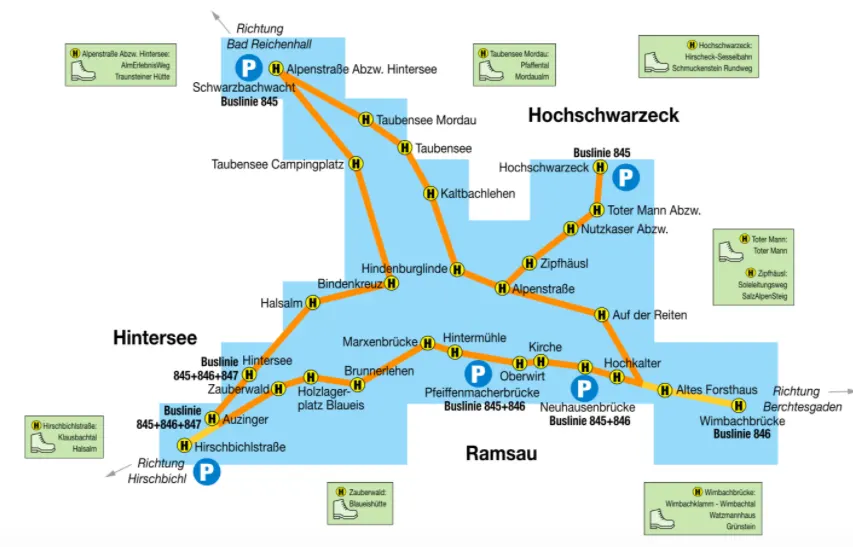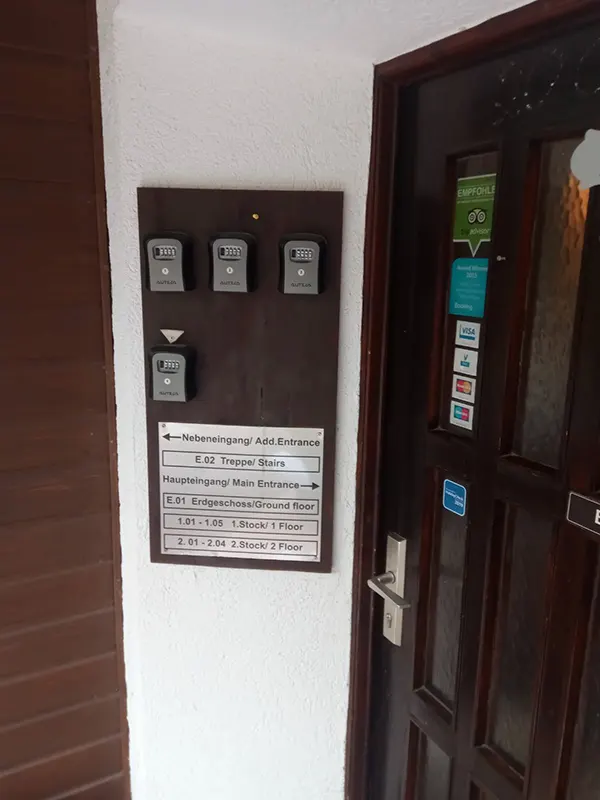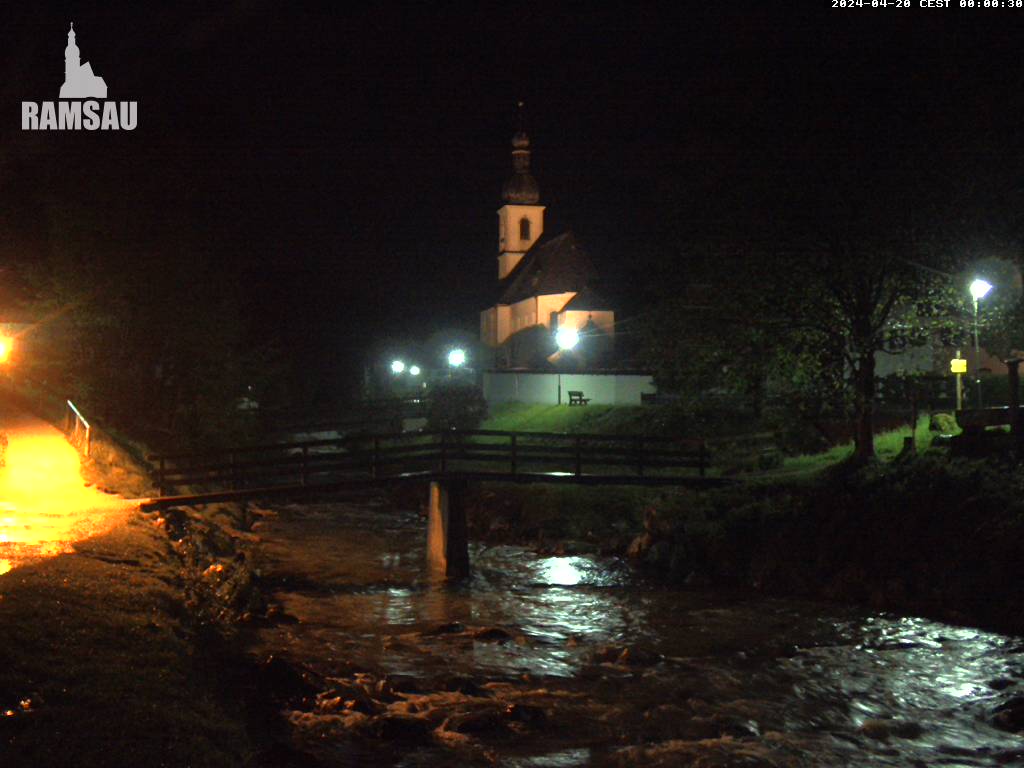The latest information
How to reach us
By car
From the city Salzburg (32 km, about 30 min)
Follow B150 in direction B305 (Ramsau, Deutschland).
Till the point of destination, Pension "Bergbach".
From Munich (142 km, about 1h 40 min)
Follow A8 towards Deutsche Alpenstrasse / B306 (Siegsdorf).
From A8 take the exit 112-Traunstein / Siegsdorf.
Follow on B306 to direction B305 (Ramsau).
Till the point of destination, Pension "Bergbach".
From the Airport "W.A.Mozart", Salzburg (35 km, about 40 min)
On Loiger Straße towards Innsbrucker Bundesstraße/B1.
Then change to B1 towards Großgmainer Landstraße.
Continue on Großgmainer Landstraße and Salzburgerstraße towards Berchtesgadener Straße/B20.
Take the B20 and change then to B305 towards Ramsau bei Berchtesgaden.
From the Airport "Franz Josef Strauss" in Munich (180 km, about 2h)
On St2584 towards A92 (Freising).
On A99 and A8 towards Deutsche Alpenstrasse / B306 (Siegsdorf).
From A8 take the exit 112-Traunstein / Siegsdorf.
Follow B306 to the direction B305 (Ramsau).
Till the point of destination - Pension "Bergbach".
Information on the parking fees in Ramsau (in German language) you can find here.
The latest information on traffic conditions in the region, you can find here: https://www.bgland24.de/service/verkehrsmeldungen
By train
The trains go not to Ramsau. The nearest train stations are in the cities Berchtesgaden and in Freilassing. Ramsau can be easily reached from Berchtesgaden during about 10 minutes with the Bus. The way from Freilassing goes via Berchtesgaden.
You can conveniently to see online possible connetctions by train from your starting point and buy train tickets. If you enter point of destination "Wimbach Brücke in Ramsau at Berchtesgaden", you can plan the entire route and to buy a tickets, only the last route from the main station in Berchtesgaden to our pension possible only with a Bus.
Here you will find the link to the website of the Deutsche Bahn www.bahn.de
To plan your journey to our Guesthouse, please fill in the field of destination the following:
From station/stop or location, street: your starting point
To station stop or location, street: Wimbachbrücke, Ramsau b. Berchtesgaden
By bus
Our guesthouse is very easy to reach by bus from the main station in Berchtesgaden with bus line 846 to the stop "Wimbachbrücke"; this stop is located directly across the street from our Pension. The way from the main station in Berchtesgaden takes only about 10 minutes.
From the main station in Berchtesgaden you can take the bus to the direction Ramsau according to the following schedule: BUS 846: "Berchtesgaden - Unterstein - Schönau - Ramsau - Hintersee 2023 timetable".
The summer timetable regional traffic Oberbayern 2023 can be found under the link.
Panorama hiking bus

Here you will find the schedule of busline 845 as well as the flyer of the new bus, which you can probably pick up in printed form from the 23rd calendar week at the Tourist-Info Ramsau.
Guests use the bus with the guest card free of charge. Locals can enjoy the round trip with the RVO day ticket.
Tourist-Information Ramsau:
Im Tal 2, 83486 Ramsau
Tel. 08657/9889-20
Information by the Tourist-Information Ramsau: Since the 1st of May 2017 the guest card of the tourist region Berchtesgaden-Königssee is being recorded electronically in the buses. For that, it is necessary to put the card to the symbol on the ticket machine or just to pull it over this symbol (see picture) - this is necessary for every journey that is being made. Please keep your guest card ready to hand when you get into the bus to avoid unnecessary delays.
Since the 1st of May 2017 the guest card of the tourist region Berchtesgaden-Königssee is being recorded electronically in the buses. For that, it is necessary to put the card to the symbol on the ticket machine or just to pull it over this symbol (see picture) - this is necessary for every journey that is being made. Please keep your guest card ready to hand when you get into the bus to avoid unnecessary delays.
Taxis Berchtesgaden
Taxizentrale Berchtesgaden e.G.:
Telephone: +49 (0)8652/4041
Fax: +49 (0)8652/4042
Bahnhofsplatz 2
D-83471 Berchtesgaden
E-Mail: Taxi-Zentrale-Berchtesgaden@t-online.de
http://www.taxizentrale-berchtesgaden.de/
TAXI Angerer:
Telephone: +49 (0)8652/964900
Königsseer Straße 33
D-83471 Berchtesgaden
E-Mail: info@taxi-angerer.de
http://www.taxi-angerer.de/
Transfer Salzburg Airport (SZG) to Ramsau near Berchtesgaden:
https://austriatransfers.at/en/transfer/salzburg-airport/ramsau-bei-berchtesgaden/1/2017-02-21/FoRm
Information for our guests
Check-in at the reception of the hotel is possible from 2:00 to 6:00 p.m. Please be advised, that the check-in counter is closed after 6:00 p.m.
Check-out time is from 8:00 till 11:00 a.m.
After 6:00 p.m you can reach us by phone: +49 8657 986 986 0 (DE) or +49 8657 986 986 01 (EN, RUS). You can pick up the key from the safe.
Where to pick up the key?

- is to be paid directly to your host.
- you will receive your personal guest card from your host upon arrival.
- advantage: You will receive discounts at many excursion destinations and sights. Just show your guest card at the individual service providers!
- in your travel documents, which were sent to you before your arrival, or directly from your landlord, you will find detailed information about the benefits of your guest card.
Guest card Bergerlebnis Berchtesgaden is currently per person and day of stay:
3,10 Euro for adults and youths over 17 years of age
1,55 Euro for children/youth (7 to 16 years)
2,50 € (80%) severely handicapped persons
(Stand: of March 2023).
With the guest card you can travel free of charge on all lines in the inner district (Zweckverband Bergerlebnis Berchtesgaden), with a few exceptions - Kehlsteinlinie, ALM-Erlebnisbus, lines to Salzburg and to the Rossfeld (toll) .
In addition, with the guest card, the entire network of lines of the RVO (with a few exceptions) can be used free of charge. This means you can take the bus to Bad Reichenhall, to the Rupertiwinkel or even to Lake Chiemsee for free.
Since March 2023, you can additionally travel free of charge by train from Berchtesgaden or Bischofswiesen via Bad Reichenhall to Salzburg. Important note: an official photo ID must be shown to the control staff upon request; not included is the return trip on bus line 840 Salzburg-Berchtesgaden ( surcharge).
Useful Information
Rescue service (ambulance service): 112
In life-threatening situations, like for example unconsciousness, acute bleedings, strong heart troubles, heavy problems with the breathing system, complications during pregnancy and poisonings please contact the ambulance service. The rescue ambulance service works 24 hours a day for medical emergencies and will be with the patient as fast as possible.
Doctors on call (medical service): 116 117
Emergency times in Bavaria:
Mon-Tue 18:00-08:00
Tue-Wed 18:00-08:00
Wed-Thu 13:00-08:00
Thu-Fri 18:00-08:00
Fri-Mon 13:00-08:00
Holiday rules:
In the evening before the holiday 18:00 until the following workday 08:00 (also valid for Shrove Tuesday, 24th and 31st of December)
With symptoms that are not life-threatening, like for example high fever, strong stomach ache or throwing up please contact the medical service. The medical emergency service can be consulted if you have health problems, because of which you would usually go to a doctor's surgery, outside of their regular opening hours, if the treatment cannot wait until the next (work)day.
Other emergency numbers:
District hospital Berchtesgaden: 08652/570
District hospital Bad Reichenhall: 08651/7720
District hospital Freilassing: 08654/6060
Bavarian Red Cross Berchtesgadener Land: 08651/95900
Dental emergency service: www.notdienst-zahn.de
Tourist-Information Ramsau:
Im Tal 2
D-83486 Ramsau
Phone: +49 (0)8657 988920
Fax: +49 (0)8657 772
Email: info@ramsau.de
Website: https://www.ramsau.de/en/service-infos/tourist-information-directions.html
Phone: 0800 00 22 8 33 (by German landline, free) or 22 8 33 (by mobile, 69 cent/min), more information (in German):
https://www.aponet.de/service/notdienstapotheke-finden.html
and
https://www.aponet.de/die-apotheke/rund-um-die-uhr-im-dienst.html
Polizei: 110
Feuerwehr: 112
Giftzentrale München: 089/19240
Frauen- und Mädchennotruf: 08031/268888
Kinder- und Jugendtelefon: 0800/1110333
Telefonseelsorge: 0800/1110111
Rechtsschutz: Verteidigernotdienst: 0172/8222211
Technische Notdienste:
Stadtwerke Bad Reichenhall (Strom/Gas/Wasser): 08651/7050
Technisches Hilfswerk Berchtesgadener Land: 08654/8706
Frauen- und Kindernotdienste:
Frauenhaus Bad Reichenhall: 0851/1819
Wasserwachten:
Bad Reichenhall: 0171/6755511
Berchtesgaden: 08650/280
Freilassing: 08654/774968
Bergwachten:
Bad Reichenhall: 08651/4000
Berchtesgaden: 112
Ramsau: 08657/202
Teisendorf: 0151/16712973











